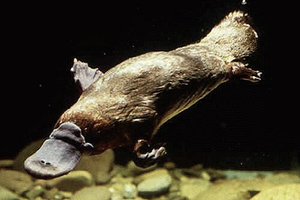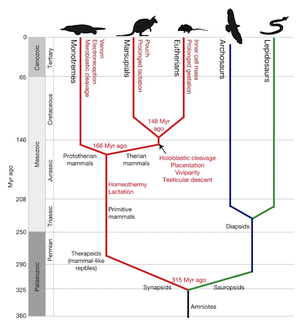Platypus Evolution
Introduction
Select a topic about genetics or evolution in a specific organism or ecosystem.
The topic must include one section about microbes (bacteria, viruses, fungi, or protists). This is easy because all organisms and ecosystems have microbes.
<be>
Platypuses (Ornithorhynchus anatinus) are monotremes, a type of egg-laying mammal with mammary glands and a flat beak. Aboriginal people in different regions have different names for the animal, including mallingong, boondaburra, and tambreet.[1] Platypuses are the only remaining member of the family Ornithorhynchidaeare, and there are only four other species of egg-laying mammals. Clearly, platypuses are unique. They live in the permanent river systems of eastern Australia, Tasmania, King’s Island, and Kangaroo Island, distributed across various environments ranging from tropical to alpine. Despite their range of environments, however, the IUCN deemed them “Near Threatened” in 2016.[2]

At right is a sample image insertion. It works for any image uploaded anywhere to MicrobeWiki. The insertion code consists of:
Double brackets: [[
Filename: PHIL_1181_lores.jpg
Thumbnail status: |thumb|
Pixel size: |300px|
Placement on page: |right|
Legend/credit: Electron micrograph of the Ebola Zaire virus. This was the first photo ever taken of the virus, on 10/13/1976. By Dr. F.A. Murphy, now at U.C. Davis, then at the CDC.
Closed double brackets: ]]
Other examples:
Bold
Italic
Subscript: H2O
Superscript: Fe3+
I don't know
Genetics
Fossil Record
The earliest known ancestors of modern platypuses lived during the early Cretaceous Period around 100 to 146 million years ago. Judging from fossil evidence, these monotremes are not very similar to modern platypuses, but a lower jaw fragment of Steropodon galmani from over 100 million years ago has platypus-like features and suggests that the mammal may have possessed a bill. The oldest known animal that is definitely a member of the platypus family is Monotrematum sudamericanum, which lived in Patagonia (South America) about 61 to 63 million years ago. At that time, Australia and South America were connected, forming a continent with Antarctica known as Gondwana.[1]
Researchers have also uncovered a fragment of a Pliocene platypus, Ornithorhynchus agilis, from roughly 3.8 million years ago. Another species, Obdurodon insignis, was identified based on two teeth in southern Australia that date back to the Oligocene approximately 26 Mya. More fossils have since been found. Fossils of Obdurodon dicksoni were in freshwater limestone from the Middle Miocene, around 15 Mya, and a larger species, Obdurodon tharalkooschild, was also found in the same area.[2]

Relations to Other Groups
Echidnas are the closest living relatives of platypuses. They have very different appearances but share key features. Both groups have a single hole for all waste excretion and reproduction, the feature that inspired the name "monotreme." Both groups lack teeth because they lost four of the eight genes needed for tooth development. This suggests that echidnas and platypuses share a common toothless ancestor. They also both lay eggs and have relatively low active body temperatures for mammals. Platypuses and short-beaked echidnas also possess furless bills/beaks with receptors that detect the electrical fields of their prey. Adult males of both groups have pointed spurs on their ankles. The spurs of platypuses are connected to functional poison glands, but those of echidnas are not.[1] The common ancestor likely had spurs, and platypuses independently evolved venom, which contains at least 19 substances, thanks to duplications in β-defensin, C-type natriuretic peptide, and nerve growth factor gene families. Interestingly, reptiles gained their venom due to the same duplications, a case of convergent evolution.[4] The skeletons of echidnas and platypuses both have many reptilian features that are not present in other mammals, adding to the similarity between platypuses and reptiles. The earliest known echidna fossils are 15 million years old at most, so little is known about the evolutionary relationship between the two groups. However, researchers currently believe that echidnas developed from a platypus-like ancestor between 18 and 90 Mya.[1]
For multiple use of the same inline citation or footnote, you can use the named references feature, choosing a name to identify the inline citation, and typing [5]
Microbiome
Include some current research, with a second image.
Conclusion
Overall text length (all text sections) should be at least 1,000 words (before counting references), with at least 2 images.
Include at least 5 references under References section.
References
- ↑ 1.0 1.1 1.2 1.3 “Evolution & Names.” Australian Platypus Conservancy, 4 Oct. 2021, https://platypus.asn.au/evolution-names/#:~:text=Aboriginal%20people%20had%20many%20different,lonely%20and%20persuasive%20water%2Drat.
- ↑ 2.0 2.1 Zhou, Yang, et al. "Platypus and echidna genomes reveal mammalian biology and evolution." Nature 592.7856 (2021): 756-762.
- ↑ [https://www.nature.com/articles/nature06936#citeas Warren, Wesley C., et al. “Genome Analysis of the Platypus Reveals Unique Signatures of Evolution.” Nature, vol. 453, no. 7192, 8 May 2008, pp. 175–183., https://doi.org/10.1038/nature06936.
- ↑ Warren, Wesley C., et al. “Genome Analysis of the Platypus Reveals Unique Signatures of Evolution.” Nature, vol. 453, no. 7192, 8 May 2008, pp. 175–183., https://doi.org/10.1038/nature06936.
- ↑ 5.0 5.1 text of the citation
Edited by Cindy Chen, student of Joan Slonczewski for BIOL 116 Information in Living Systems, 2022, Kenyon College.
